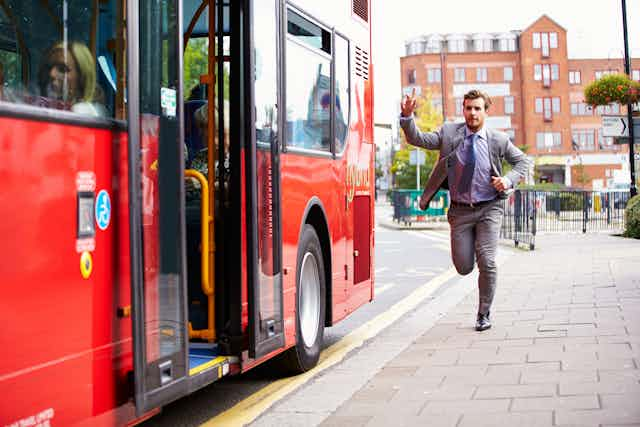Oncoming Bus So I Never Have to Go to Work Again I Just Keep Messing Up the Bus Schedule

Math explains why your bus route seems so unreliable
Have yous ever waited for your bus at a bus stop for a very long fourth dimension – just to be greeted by two or more buses arriving together?
This phenomenon, known as "double-decker bunching," is a problem that bus transit systems around the world have been trying to solve for decades. During this time, researchers accept used mathematical models to study the behavior of bus transit systems to meliorate empathise why this happens. The mathematics identify what causes this problem – and also suggests that jitney-tracking technology tin can be combined with uncomplicated control algorithms to improve the situation.
Bunching is annoying for riders, since it increases both the average time spent waiting for the double-decker and the variability in this waiting time.
Bunching also makes the bus system less reliable, because it causes buses to get off schedule. The long waits induced by bunching can also cause people to shift away from buses toward other, less sustainable modes of transportation.
Autobus bunching occurs considering charabanc routes are inherently unstable. When the buses are on schedule, everything seems to work fine. They travel from stop to stop, waiting at each for passengers to exit or climb aboard. All the same, once a bus gets backside schedule, information technology'due south most impossible for it to get back on track. It will continue to get farther and further backside schedule until the next bus on the road catches up.
The same thing happens to buses that are early: They continue to get before and before as they travel through their route, until they take hold of up to the bus just ahead.
Equations that describe how buses move forth a route identify why this happens. The time buses spend serving passengers at a finish is related to the amount of time between consecutive bus arrivals, commonly known as charabanc headway. When a double-decker runs tardily, its headway increases and more passengers go far that need to be served at its next terminate. But the more than passengers waiting at a stop, the longer a charabanc needs to spend in that location. So late buses demand to spend more fourth dimension at each subsequent stop, causing them to run fifty-fifty later. The opposite happens for a motorbus that'due south early. This cycle continues until multiple buses eventually grab upward to each other and bunch.
So what can be done to stop this? Transit agencies have worked with researchers such every bit ourselves to suggest many different ideas to eliminate omnibus bunching.
One strategy is to instruct late buses to skip stops where passengers don't need to get off or to limit the number of people immune to board late buses at each stop. Both of these allows the late bus to spend less time at each stop, which allows information technology the opportunity to catch up. Of grade, doing so can leave potential users stranded.
Another common strategy is to build more time than needed into a bus's schedule. This boosted time – chosen slack – helps accommodate the variability in bus travel time. Buses that are early on are instructed to hold at selected stops until the scheduled time to depart. However, this strategy does not help late buses recover. It's also susceptible to whatsoever disturbances that cause buses to get off schedule. Delaying or holding buses in this manner likewise reduces the speed at which passengers can travel forth the route.
New engineering science may be able to assist. Transit agencies tin can at present track the location of buses in real fourth dimension and offer tailored feedback to drivers. These novel strategies care for sequent buses as if they were all continued past springs. Buses that are too close together along the road are given instructions to help "push" them apart, while buses that are too far apart are given information to help "pull" them dorsum together. Drivers might be told to spend this much actress fourth dimension to spend at a finish or to travel that much slower or faster forth a route.
Researchers have developed algorithms that agencies can utilise to provide such instructions to individual buses and avoid bus bunching. These instructions could be sent from dispatchers at the transit agency who monitor the system and provide unproblematic guidance to drivers or through on-board computers that calculate exactly what drivers should do to forestall bunching automatically. Computer simulations and field tests suggest that these dynamic strategies may one 24-hour interval make bunching a thing of the past.
Pembaca kami
Jumlah pembaca The Conversation sebanyak 18 juta pengguna setiap bulan, dan melalui Creative Commons republikasi menjangkau 42 juta pembaca.
Mau menulis?
Tulis artikel dan bergabung dengan komunitas akademisi dan peneliti yang terus tumbuh dengan lebih dari 144.900 dari 4.356 lembaga.
Daftar sekarang
morristhisicland67.blogspot.com
Source: https://theconversation.com/math-explains-why-your-bus-route-seems-so-unreliable-95485
0 Response to "Oncoming Bus So I Never Have to Go to Work Again I Just Keep Messing Up the Bus Schedule"
Postar um comentário